There are thousands of photos taken over the years that supposedly capture something of a supernatural nature - unexplained lights, figures, or orbs. But there are only a handful of them that are truly considered as real potential evidence, and remain to this date unexplained. These particular photos have been analyzed by labs and photography experts again and again in an attempt to explain them, replicate them, or disprove them. Despite all the effort that has gone to prove them as hoaxes – no foul play or trickery has been uncovered. These photos are rarities in the fact that they continually appear to be just what they seem to be: genuine photographic evidence of, for a lack of a better word… ghosts.
The Brown Lady
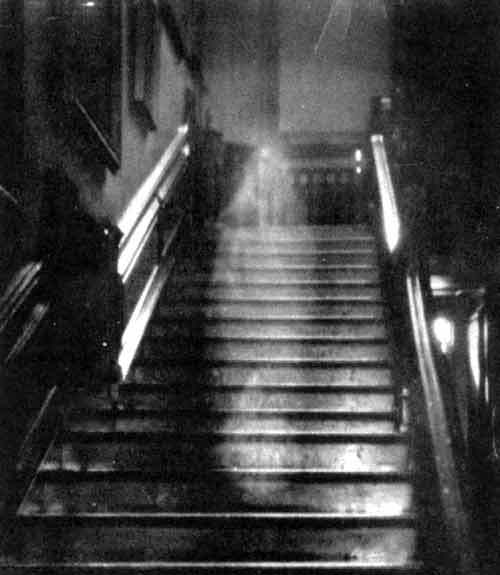
This portrait of "The Brown Lady" ghost is arguably the most famous and well-regarded ghost photograph ever taken. The ghost is thought to be that of Lady Dorothy Townshend, wife of Charles Townshend, 2nd Viscount of Raynham, residents of Raynham Hall in Norfolk, England in the early 1700s. It was rumored that Dorothy, before her marriage to Charles, had been the mistress of Lord Wharton. Charles suspected Dorothy of infidelity. Although according to legal records she died and was buried in 1726, it was suspected that the funeral was a sham and that Charles had locked his wife away in a remote corner of the house until her death many years later.
Dorothy's ghost is said to haunt the oak staircase and other areas of Raynham Hall. In the early 1800s, King George IV, while staying at Raynham, saw the figure of a woman in a brown dress standing beside his bed. She was seen again standing in the hall in 1835 by Colonel Loftus, who was visiting for the Christmas holidays. He saw her again a week later and described her as wearing a brown satin dress, her skin glowing with a pale luminescence. It also seemed to him that her eyes had been gouged out. A few years later, Captain Frederick Marryat and two friends saw "the Brown Lady" gliding along an upstairs hallway, carrying a lantern. As she passed, Marryat said, she grinned at the men in a "diabolical manner." Marryat fired a pistol at the apparition, but the bullet simply passed through.
This famous photo was taken in September, 1936 by Captain Provand and Indre Shira, two photographers who were assigned to photograph Raynham Hall for Country Life magazine. This is what happened, according to Shira:
"Captain Provand took one photograph while I flashed the light. He was focusing for another exposure; I was standing by his side just behind the camera with the flashlight pistol in my hand, looking directly up the staircase. All at once I detected an ethereal veiled form coming slowly down the stairs. Rather excitedly, I called out sharply: 'Quick, quick, there's something.' I pressed the trigger of the flashlight pistol. After the flash and on closing the shutter, Captain Provand removed the focusing cloth from his head and turning to me said: 'What's all the excitement about?'"
Upon developing the film, the image of The Brown Lady ghost was seen for the first time. It was published in the December 16, 1936 issue of Country Life. The ghost has been seen occasionally since.
Freddy Jackson Finds His Way into the Photo
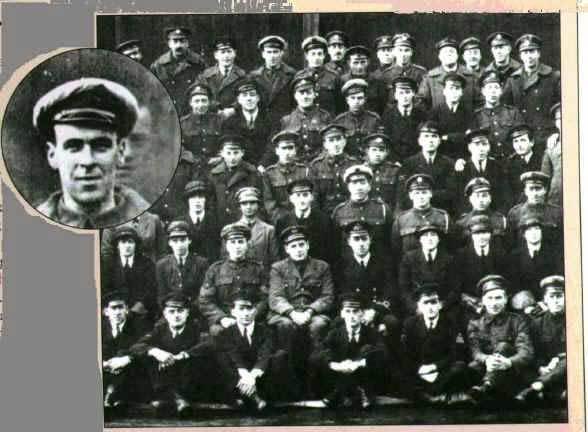
This is one of the most widely publicized ghost pictures in existence. The photo, published in 1975 by retired Royal Air Force officer Sir Victor Goddard, was actually taken in 1919. The photo is a group picture of Goddard’s squadron which had served in World War I.
After a close examination, an unexpected ghostly face was discovered in the photo. In back of the airman positioned fourth from the left on the top row, it is clearly possible to see the face of another man peering from behind his head.
It is said to be the face of Freddy Jackson, an air mechanic who had been accidentally killed by an airplane propeller two days earlier. His funeral had taken place on the day this photograph was snapped. Members of the squadron easily recognized the face as Jackson's. It has been suggested that Jackson, unaware of his death, decided to show up for the group photo.
Staircase Specter
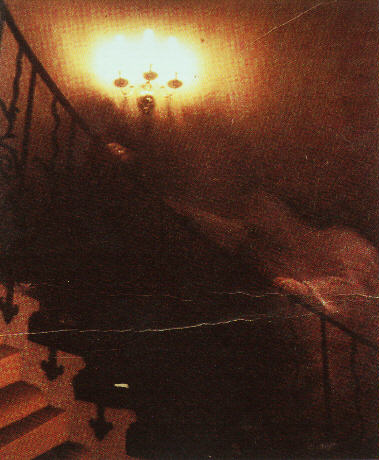
The picture was taken on June 19, 1966 by the Reverend Ralph W. Hardy of White Rock, British Columbia. He intended merely to photograph the elegant spiral staircase (known as the "Tulip Staircase") in the Queen's House section of the National Maritime Museum in Greenwich, England. However, after he and his wife returned to Canada and had the pictures developed, the Hardy’s saw the figures in the resulting photos. They sent the original negatives to England’s Ghost Club for evaluation.
Each picture on the roll was accounted for by number. The picture immediately prior to the ghost picture is of the colonnade outside the Queen's House and the one immediately following is of a figurehead. Neither bears any resemblance to the shrouded figure(s).
The picture is visually confusing until you realize the strange angle at which it was taken. It was shot from beneath a curving stairway looking up and the bulk of architecture you see to the left is the underside of the staircase. The Hardys were on vacation and Mrs. Hardy wanted a photograph that would duplicate a picture she'd seen in a magazine. When they got to the staircase (a famous architectural feature of the house) they discovered that they couldn't duplicate the picture in the magazine, which was taken from the top of the stairs, because that area was off limits and, in fact, the stairs themselves were blocked to keep everyone off them.
The only shot Rev. Hardy could get of the staircase was the awkward angle from below, with the chandelier overhead, so that is the one he took. At the time there was, of course, no one on the stairs. The Hardy’s didn't discover the figures (if you look closely, there are actually two figures) until they were back in Canada. They turned the original negative over the England's Ghost Club, along with the negatives for the pictures before and after it on the roll. The Ghost Club sent them to Kodak laboratories for analysis and the experts who examined them pronounced them to be not tampered with and said the only explanation for the figures had to be that there was someone or something on the stairs. (1)
Mrs. Mabel’s Mother
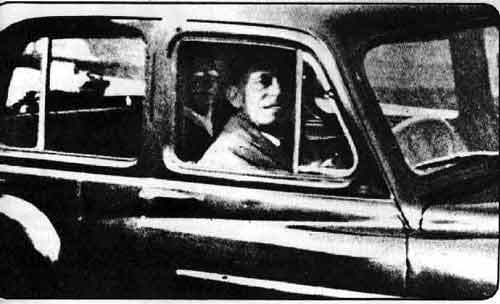
Mrs. Mabel Chinnery was visiting the grave of her mother one day in 1959. She had brought along her camera to take photographs of the gravesite. After snapping a few shots of her mother's gravestone, she took an impromptu photo of her husband, who was waiting alone in the car. At least the Chinnerys thought he was alone.
When the film was developed, the couple was more than surprised to see a figure wearing glasses sitting in the back seat of the car. Mrs. Chinnery immediately recognized the image of her mother – the woman whose grave they had visited on that day.
A photographic expert who examined the print determined that the image of the woman was neither a reflection nor a double exposure. "I stake my reputation on the fact that the picture is genuine," he testified.
Ghost in the Burning Building
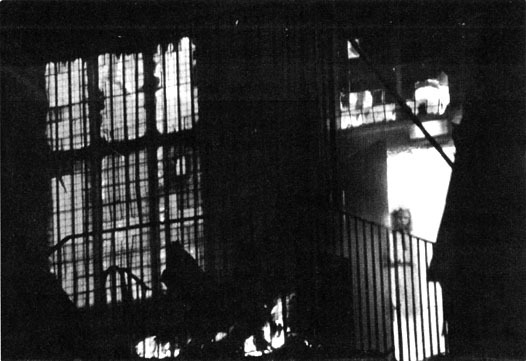
On November 19, 1995, Wem Town Hall in Shropshire, England burned to the ground. Many spectators gathered to watch the old building, built in 1905, as it was being consumed by the flames. Tony O'Rahilly, a local resident, was one of those onlookers and took photos of the spectacle with a 200mm telephoto lens from across the street. One of those photos shows what looks like a small, partially transparent girl standing in the doorway. Neither O'Rahilly nor any of the other onlookers or firefighters recalled seeing the girl there.
O'Rahilly submitted the photo to the Association for the Scientific Study of Anomalous Phenomena which, in turn, presented it for analysis to Dr. Vernon Harrison, a photographic expert and former president of the Royal Photographic Society. Harrison carefully examined both the print and the original negative, and concluded that it was genuine. "The negative is a straightforward piece of black-and-white work and shows no sign of having been tampered with," Harrison said.
Newby Church
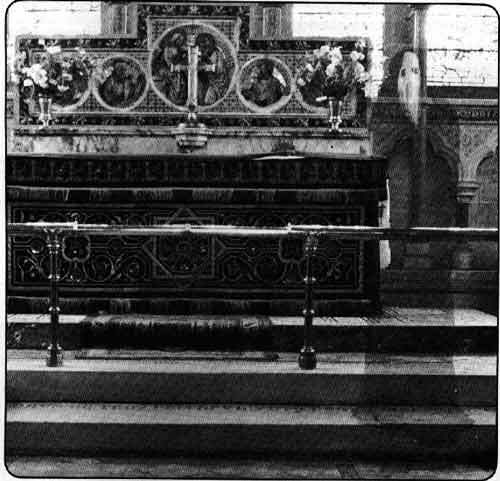
This photograph was taken in 1963 by Reverend K. F. Lord at Newby Church in North Yorkshire, England. It has been a controversial photo because it is just too good. The shrouded face and the way it is looking directly into the camera makes it look like it was posed – a clever double exposure. Yet supposedly the photo has been scrutinized by photo experts who say the image is not the result of a double exposure.
The Reverend Lord has said of the photo that nothing was visible to the naked eye when he took the snapshot of his altar. Yet when the film was developed, standing there was this strange cowled figure.
The Newby Church was built in 1870 and, as far as anyone knows, did not have a history of ghosts, hauntings or other peculiar phenomena. Those why have carefully analyzed the proportions of the objects in the photo calculated that the specter is about nine feet tall.
I agree that this one looks almost too good to be true… but the figure in the photo gives me the creeps all the same.
The Vacation Crasher at Hotel Vierjahreszeiten
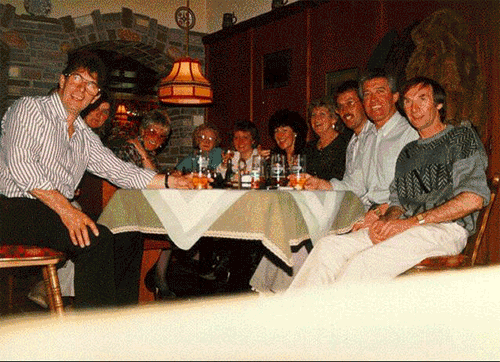
These two photos were taken in 1988 at the Hotel Vierjahreszeiten in Maurach, Austria. Several vacationers gathered for a farewell party at the hotel and decided to take a group photo. One of the party, Mr. Todd, set up is Canon film camera on a nearby table and pointed it at the group. (The table is the white band at the bottom of the photos.) He set the self-timer on the camera and hurried back to the table. The shutter clicked and the film wound forward, but the flash did not fire. So Todd set the camera for a second shot. This time the flash fired.
The film was later developed, and it wasn't until one of party members was viewing the photos that it was noticed that the first (non-flash) photo showed a somewhat blurry extra head! (In the sequence above, the second (flash) photo is actually shown first for the sake of comparison.) No one recognized the ghostly woman, and they could not imagine how her image appeared in the picture. Besides being a bit out of focus, the woman's head is also too large compared to the other vacationers, unless she is sitting closer to the camera, which would put her in the middle of the table.
The photo was examined by the Royal Photographic Society, the photographic department of Leicester University, and the Society for Psychical Research, all of which ruled out a double exposure as the cause.
Lord Combermere Photograph
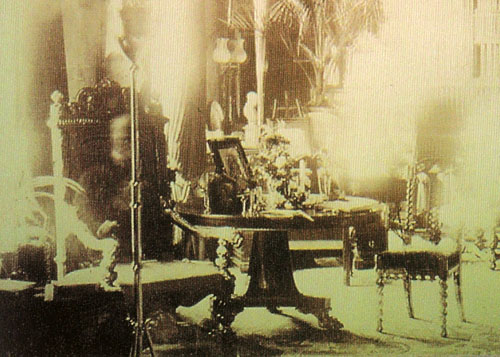
The photo shown here is the famous "Lord Combermere Photograph", which was first published in 1895. It gained almost instant fame among psychic researchers and remains a mystery to this day.
The photo was part of an account by Miss Sybell Corbett who took the photograph in December 1891 while staying with her sister at Combermere Abbey in Cheshire, England. The photo was actually taken of the splendid library of the house and the camera was placed with a long exposure of about one hour, details of which were carefully noted in her photographic diary.
Although no one was in the room at the time of the exposure, the developed plate showed the head, body and arms of an older man, seated in a high-backed chair to the left side of the room.
The photo was shown to a relative of Lord Combermere and she announced that if did resemble the man. However, not everyone agreed about this. Regardless, the features of the man are hard to distinguish.
The strangest thing about the photo was that, at the time it was taken, Lord Combermere was attending a funeral at the local churchyard in Wrenbury, a few miles away. The funeral was his own! Lord Combermere had been killed a few days earlier in a road accident in London.
As mentioned, the photo caused quite a stir and attracted the attention of Sir William Barrett, an investigator for the Society of Psychical Research. He experimented with a similar photo process and then first dismissed this photograph as an unintentional mistake. He surmised that a servant had entered the room while the shutter of the camera was open, sat down in the chair and then left, leaving behind a faint, and rather "ghostly" image.
After further investigation though, Barrett reconsidered. He later learned that the image did not resemble any of the servants in the house and that all of the male servants had been away attending their master’s funeral anyway. He confessed to being perplexed and the photograph remains mysterious today.
Bachelor's Grove Cemetery
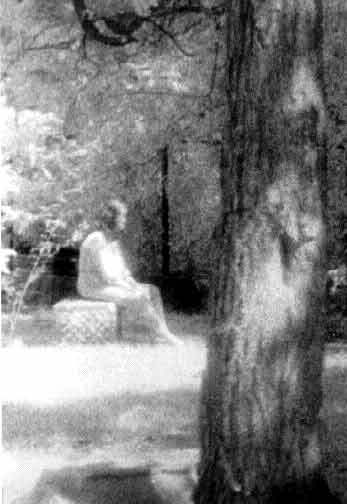
This photo was taken during an investigation of Bachelor's Grove Cemetery near Chicago by the Ghost Research Society (GRS).
On August 10, 1991, several members of of the GRS were at the cemetery, a small, abandoned graveyard on the edge of the Rubio Woods Forest Preserve, near the suburb of Midlothian, Illinois.
Reputed to be one of the most haunted cemeteries in the U.S., Bachelor's Grove has been the site of well over 100 different reports of strange phenomena, including apparitions, unexplained sights and sounds, and even glowing balls of light.
GRS member Mari Huff was taking black and white photos with a high-speed infrared camera in an area where the group had experienced some anomalies with their ghost-hunting equipment.
The cemetery was empty, except for the GRS members.
When developed, this image emerged: what looks like a lonely-looking young woman dressed in white sitting on a tombstone. Parts of her body are partially transparent and the style of the dress seems to be out of date.
Other ghosts reportedly seen in Bachelor's Grove include figures in monks' clothes and the spirit of a glowing yellow man.
Chloe Roaming the Grounds of the Myrtles Plantation
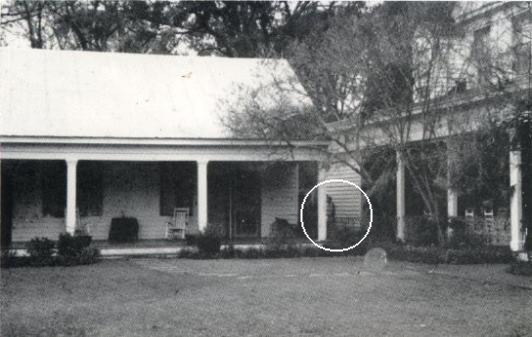
 On the Smithsonian's list of the most haunted places in the world, the Myrtles Plantation is located in St. Francisville, Louisiana. A small town with a few stories and a number of ghosts to back them up. In fact, you could argue that it may have as many ghosts as any place in America. No less than ten murders have been committed here since 1794.
On the Smithsonian's list of the most haunted places in the world, the Myrtles Plantation is located in St. Francisville, Louisiana. A small town with a few stories and a number of ghosts to back them up. In fact, you could argue that it may have as many ghosts as any place in America. No less than ten murders have been committed here since 1794.The Myrtles Plantation was built in 1794 by General David Bradford. It is said that he built it on an Indian burial ground, which is not usually a good start for a haunting depending on how you look at it.
Sara Matilda, the daughter of David Bradford, married Judge Clark Woodruffe and they moved into the Myrtles. Sara Matilda had given birth to two daughters and was carrying a third child, when the Myrtles major event took place.
Although Woodruffe had a reputation in the region for integrity with men and with the law, he was also known for being promiscuous. He started an intimate relationship with one of his slaves. This practice itself was not entirely uncommon with slaves at the time. This particular female slave was named Chloe. She was a household servant who could have been sent to work in the fields if she refused the sexual advances of the Judge.
Woodruffe eventually tired of Chloe and moved on to another mistress. Chloe then began eavesdropping on the Woodruffe family's private conversations. One day, the Judge caught her at this and ordered that one of her ears be cut off to teach her a lesson and to put her in her place. After that time, she would always wear a green turban around her head.
What happened next is still unclear. Some claim that the next event was done so that the family would just get sick and then Chloe could nurse them back to health and earn the Judge's gratitude and some claim that it was done for nothing more than vengeance.
Chloe put a small amount of oleander leaves, similar to arsenic poison, into a birthday cake that was made for the birthday of Judge's oldest daughter. The two children, and Sara Matilda, each had slices of the tainted cake. The Judge did not. By the end of the day, all of them were very sick. Chloe patiently attended to their needs, never realizing (if it was an accident) that she had given them too much poison.... in just hours, they were all three dead.
The other slaves, afraid that the Judge would punish them as well, dragged Chloe outside and hanged her from a plantation tree. Her body was later cut down, weighted with rocks and thrown into the river. The Judge closed off the children's dining room, where the party was held, and never allowed it to be used again as long as he lived, which wasn't long, for he too was slain by a murderer a few years later. To this day, the room has never again been used for dining. It is called the game room today.
Since then, Chloe's ghost has been reported at the Myrtles and has even been accidentally photographed by the current owner. A photo that she took of the house showed a shadowy figure in a turban standing near the building. Her spirit has also been seen in the house, perhaps seeking the ghost of the Judge who escaped her revenge. (2)
Watery Faces off the S.S. Watertown
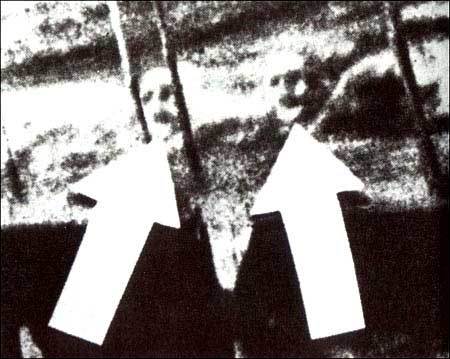
James Courtney and Michael Meehan, crew members of the S.S. Watertown, were cleaning a cargo tank of the oil tanker as it sailed toward the Panama Canal from New York City in December of 1924. Through a freak accident, the two men were overcome by gas fumes and killed. As was the custom of the time, the sailors were buried at sea off the Mexican coast on December 4.
But this was not the last the remaining crew members were to see of their unfortunate shipmates. The next day, before dusk, the first mate reported seeing the faces of the two men in the waves off the port side of the ship. They remained in the water for 10 seconds, then faded. For several days thereafter, the phantom-like faces of the sailors were clearly seen by other members of the crew in the water following the ship.
On arrival in New Orleans, the ship's captain, Keith Tracy, reported the strange events to his employers, the Cities Service Company, who suggested he try to photograph the eerie faces. Captain Tracy purchased a camera for the continuing voyage.
When the faces again appeared in the water, Captain Tracy took six photos, then locked the camera and film in the ship's safe. When the film was processed by a commercial developer in New York, five of the exposures showed nothing but sea foam. But the sixth showed the ghostly faces of the doomed seamen.
The negative was checked for fakery by the Burns Detective Agency. After the ship's crew had been changed, there were no more reports of sightings.
Tewin Bury Farm
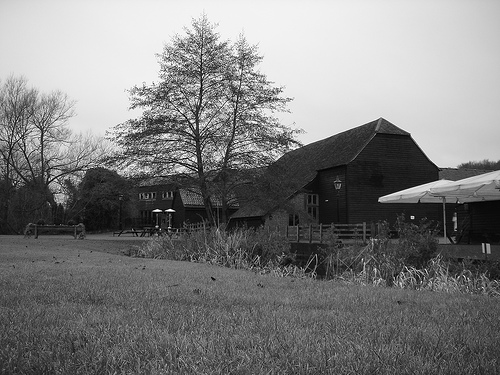

copyright: Neil Sandbach
This is one of the most recent photos to join the ranks of the unexplained. This amazing photo was taken by photographer and graphic designer Neil Sandbach in 2006. Neil was photographing some scenic shots at a farm Hertfordshire, England, as part of a project for wedding stationery; the couple planned to have their wedding ceremony held there. In his own words:
I took this photo to be used on a wedding invite for my friends Jonathan and Nikki's wedding. When I opened the file in Photoshop to lighten it up a bit and noticed the white figure in the distance on the right - staring right at me! It also appears to have no legs!
I didn't think it was a ghost but I emailed it to my friends for fun. Many people are positive it is supernatural.
Before the wedding, and without mentioning this photograph, the couple getting married asked the staff at the venue if anyone had ever seen something 'spooky'. They went white and described what they and some cleaners had seen: the ghost of a young boy dressed in white night clothes, appearing close to the main barn!
Spooky? A beautiful setting and venue none the less.
Details of the photo can be found here.
My daughter is currently taking a digital art class in high school, and I’m convinced with a little bit of Photoshop expertise, she herself could create her own portfolio of ghost pictures. And as me move solidly into the digital age, I’m sure it will be more and more difficult to believe in the legitimacy of pictures that capture ghostly images - as well as to either authenticate or disprove them. But regardless of how indisputable these examples of photographic proof may be - during Halloween week it’s an enjoyably spooky escape to investigate this apparent evidence ghosts, spirits, and specters.
Happy Halloween!
Unless otherwise noted, photos courtesy of About.com: Paranormal Phenomena
(1) http://www.ghost-mysteries.com/forum/index.php?showtopic=60
(2) http://www.myrtlesplantation.com/






Comments